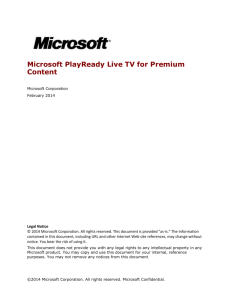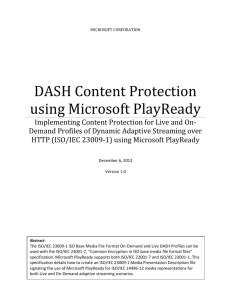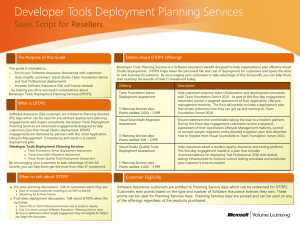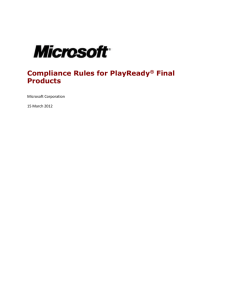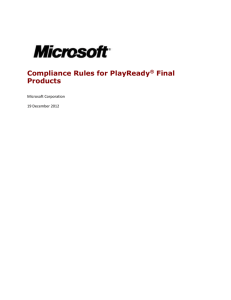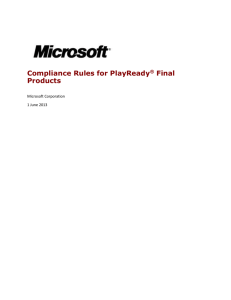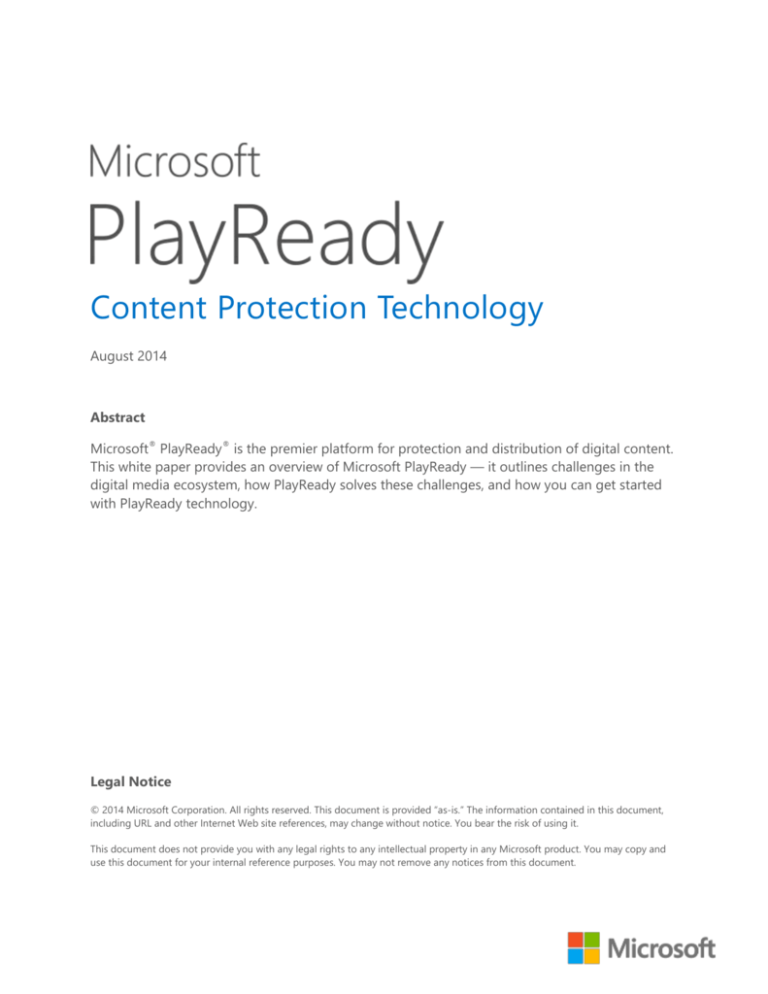
Content Protection Technology
August 2014
Abstract
Microsoft® PlayReady® is the premier platform for protection and distribution of digital content.
This white paper provides an overview of Microsoft PlayReady — it outlines challenges in the
digital media ecosystem, how PlayReady solves these challenges, and how you can get started
with PlayReady technology.
Legal Notice
© 2014 Microsoft Corporation. All rights reserved. This document is provided “as-is.” The information contained in this document,
including URL and other Internet Web site references, may change without notice. You bear the risk of using it.
This document does not provide you with any legal rights to any intellectual property in any Microsoft product. You may copy and
use this document for your internal reference purposes. You may not remove any notices from this document.
Microsoft PlayReady
Content Protection Technology
Table of Contents
Introduction....................................................................................................................................................................... 2
Media and Entertainment Trends ............................................................................................................................. 2
Challenges ..................................................................................................................................................................... 3
The Future ..................................................................................................................................................................... 4
The Solution: Microsoft PlayReady ........................................................................................................................... 4
PlayReady in Action ................................................................................................................................................... 5
Key Features ................................................................................................................................................................. 6
Business Models.......................................................................................................................................................... 7
Distribution Options .................................................................................................................................................. 8
The PlayReady Product Suite ...................................................................................................................................... 8
PlayReady Clients........................................................................................................................................................ 8
PlayReady Servers ................................................................................................................................................... 10
Get Started With PlayReady ..................................................................................................................................... 11
Which License Do I Need? ................................................................................................................................... 11
1
Microsoft PlayReady
Content Protection Technology
Introduction
Well-understood business models for creating, distributing, and monetizing media content have
seen considerable upheaval in recent years. The need for protecting the distribution of premium
content has precipitated the need for digital rights management (DRM) systems. This white
paper provides a brief summary of recent trends and challenges in the digital media ecosystem,
followed by an introduction to Microsoft’s content protection solution to these challenges:
Microsoft PlayReady.
Media and Entertainment Trends
What we watch and how we watch is changing. We’re at the beginning of a major historical shift
from watching scheduled TV programming to watching Live TV and video on a plethora of
devices, including mobile phones, tablets and smart TVs. Content formats and protection
systems are no longer tied to a single consumption platform, and there is a growing trend to
bring managed content experiences to unmanaged devices. The devices are now internetenabled and mobile, and the number of these devices continues to grow. The availability of
multiple consumption outlets helps to blur the distinction between web and broadcast media:
consumers may consume content on smart phones, tablets, gaming consoles, smart TVs, IP
streaming boxes, or connected Blu-ray players. In fact, web and broadcast media are becoming
relatively indistinguishable to consumers as 25% of all U.S. homes now have at least one
television connected to the internet. 1
The time spent consuming content is growing:
In 2013, U.S. homes receive a record 118 TV channels on average. 1
According to a recent study, 83 percent of consumers watch Live TV more than once a
week, up from 79 percent the previous year.2
Today, 60 percent of consumers watch VoD content on a weekly basis.1
Video on demand (VoD) traffic is estimated to triple by 2016 (the amount of VoD traffic in 2016
will be equivalent to 4 billion DVDs per month).1
1
2
Cisco, “Networking Visual Index: Forecast and Methodology, 2011-2012”
“Linear TV Viewing Still Matters As Cord-Cutting Trend Expands: Study,” Multichannel News, 2013
2
Microsoft PlayReady
Content Protection Technology
Content is a huge investment:
The average movie costs at least $65 million to produce.3
In 2012, worldwide revenue for movies totaled $62 billion.4
Each of the U.S. broadcast TV networks is expected to pay an annual average of at least $1
billion to carry NFL games.5
However, a great deal of that investment is often lost to piracy:
A study conducted by LEK Consulting LLC found that around $6.1 billion per year of
revenue is lost to film piracy.6
Cable TV pirates in the Asia-Pacific region had siphoned off $874 million in revenue during
one year, and the problem is growing at about 11 percent per year.7
As content becomes more expensive to produce and more of that investment is lost to piracy,
robust DRM systems become even more important to content owners for protecting their
investment.
Challenges
From the perspective of the digital media ecosystem, there are currently three main challenges:
The number of digital media devices is growing.
Consumers are consuming more content on these devices.
Content providers are delivering higher quality and resolution of content.
Tactics to protect and monetize content are more crucial today than in years past.
Customers want connectivity everywhere, and they want interactive personalized experiences on
their device of choice, with their preferred applications. To meet the demands of consumers,
network operators must deliver a huge amount of data in order to deliver compelling
experiences with high quality. Because these content experiences are moving to multiple
consumption outlets — some of which are unmanaged — well-understood business models for
monetizing content are no longer the rule. For example, high-value movie content is often now
available via over-the-top (OTT) services on the same day as it appears in movie theaters.
C. Ullrich, “MPAA: In 2006, An Average Studio Movie Cost $65.8M To Produce,” Moviefone, 2007.
D. Lieberman, “Worldwide Consumers Spent $62.4B on Movies In 2012, Up 2.1%,” Deadline, 2013.
5
Kaplan, Dan & Ourand, John, “Another Jackpot for NFL,” SportsBusiness Daily, 2011.
6
S. McBride & G. A. Fowler, “Studios See Big Rise In Estimates of Losses to Movie Piracy,” Wall Street Journal, 2006
7
N. Soh, “SINGAPORE: $1.5b in revenue lost to cable TV piracy in the region,” UCLA International Institute, 2003
3
4
3
Microsoft PlayReady
Content Protection Technology
Content protection systems must be able to scale to the growing number of devices. Also, these
content systems must be versatile enough to handle an increasing variety of consumption
platforms while also maintaining the robustness required to provide reliable security across all
services and devices. Content protection systems must be flexible enough to handle the various
business scenarios that the expanding digital media ecosystem will inevitably produce.
The Future
The future holds several important shifts in the digital media ecosystem. Security is moving into
hardware, apps are giving way to browsers, networks are becoming mere pipes for OTT content,
and content delivery is moving to the cloud:
Today
Software-based security
Dedicated applications
Managed networks
On-premises based delivery
Tomorrow
Software and Hardware-based security
Standards-based HTML5 playback
OTT streaming, and managed networks
Hybrid (Cloud and on-premises) based delivery
Content protection systems must evolve to support these changes, embrace new standards such
as HTML5 Encrypted Media Extensions (EME), move to open technologies such as Dynamic
Adaptive Streaming over HTTP (DASH), and anticipate the shift to ultra-high resolution
(UHD/4K) content.
The Solution: Microsoft PlayReady
Microsoft PlayReady is a comprehensive content delivery and management solution for
entertainment products and services across all platforms and types of devices. Developed by
Microsoft, PlayReady is the result of over 14 years and over $2 billion in R&D. Thanks to a full IP
patent portfolio, proven robustness, and backing by a dedicated breach response team,
PlayReady has become the leading DRM system for protecting media content. Microsoft’s
ongoing commitment to secure, user-friendly protection of content and cross-platform
capabilities inherently positions Microsoft PlayReady as a key enabler for the media and
entertainment industry.
PlayReady is proven, versatile, and scalable throughout the digital media ecosystem:
PlayReady is already approved by major Hollywood studios, the Digital Entertainment
Content Ecosystem, UltraViolet™, and HbbTV®.
PlayReady provides support for multiple business models including subscription, pay-perview, rental, ad-based, and purchase.
PlayReady offers multiple distribution options such as download, streaming, and DLA-OTA.
PlayReady is available on multiple platforms including Android, iOS, Windows and
Windows Phone, Xbox, and various types of consumer electronics devices.
4
Microsoft PlayReady
Content Protection Technology
HTML5 platforms have leveraged PlayReady and many PlayReady
endpoints now support MPEG-Dash. PlayReady in Action
In general, content protection systems are designed to do the following:
1. Secure the distribution of digital content.
2. Allow rights to that content to be specified and enforced.
PlayReady secures content by encrypting data files. These encrypted files may be moved,
archived, streamed, copied, or distributed without restrictions. In order to decrypt these data
files, a digital key is required. This key is contained within a license. Each license also contains
rights and policies that specify how the files may be used, and under what conditions.
Figure 1 - Content Consumption Model
Figure 1 offers a typical example of how PlayReady secures and manages content consumption:
1. Before content can be distributed for playback, it must first go through an encryption step
to protect the content.
2. An encoder encrypts the content using an encryption key that is also made available to
the license server.
3. After the content is encrypted, it is staged for delivery to playback clients (typically via a
content distribution network).
4. PlayReady clients discover content within the application developed for the service.
5. To decrypt content, a PlayReady client sends a license request to a PlayReady license
server.
6. The PlayReady license server authenticates the client and issues a license back to the client.
7. As the client uses the license key to unencrypt the content, it plays back the content
according to the policies specified in the license. Some of the common policies utilized are
time based restrictions and output protections (for example, restricting playback to a
secure HDMI port to safeguard against copying).
5
Microsoft PlayReady
Content Protection Technology
PlayReady supports many variations on this content consumption model. The license can be
embedded in the content rather than distributed via a license server, and multiple clients can
share a single license (domains).
Key Features
The following list summarizes the key features of PlayReady technology.
Secure License
Delivery
PlayReady securely delivers licenses to clients — every client has a
unique certificate that authenticates the client to PlayReady servers.
Key Rotation
For Live TV scenarios, PlayReady provides support for key rotation,
where the encryption keys protecting the content change on a
frequent and specified basis. PlayReady for Live TV also supports ad
insertion and blackouts.
Output Protection
PlayReady can enforce the restriction of playback to only secure
output ports on playback devices based on license policies.
Domains
PlayReady supports the concept of domains. A PlayReady domain is
a group of devices that can share a domain bound content license.
PlayReady domains can also managed the number of devices a
services allows per account.
Metering
PlayReady supports metering, where the playback client maintains a
count of how many times a content file is played.
ND Streaming
PlayReady for Network Devices (ND) is designed for in-home
streaming scenarios to extend the reach of a managed network to
devices via DRM. PlayReady ND also enables CAS to DRM for in
home viewing on devices.
Breach Response
PlayReady actively manages the device ecosystem and has processes
in place to manage clients in the unlikely event of a security breach.
Multiple Client
Platforms
PlayReady supports a range of client platforms including Windows,
Xbox, iOS, and Android. PlayReady is also available for set-top boxes
and other consumer electronics devices such as TVs and media
players.
Multiple Content
Types
The format extensibility of PlayReady supports essentially any type of
content, including movies, live TV, music, games, ringtones and
images, and is commonly used with the following audio and video
formats: For audio content, support includes AAC, AAC+, and WMA
codecs. For video content, support includes H.263, H.264 and H.265
codecs.
6
Microsoft PlayReady
Content Protection Technology
Business Models
PlayReady technology supports a wide range of business models for delivering digital content.
Business models supported by PlayReady include:
Subscription
Subscriptions allow a service provider to charge a flat rate for access to any
or all content in the service provider’s catalog. PlayReady supports
subscription models through three mechanisms:
Time Length
The license issuer can specify the length of time for
which a license is valid, thus ensuring that access to
the content expires when the subscriber cancels their
subscription. While the subscription is active, the
licenses are renewed prior to expiration so that the
user enjoys uninterrupted playback.
License
Chaining
A service provider can provide a root license which
contains the subscription’s time based policies.
Connected leaf licenses are delivered for each piece
of content. If the root license expires and is not
renewed then the leaf licenses will no longer work.
This simplifies the license process for services which
provide numerous offline files such as music
subscriptions
Pay-per-view
PlayReady supports the pre-delivery of content licenses as well as
acknowledgement from the client that the license was successfully stored.
This provides assurance to the service that the client can consume the
content during the payment and provisioning process.
Rental
PlayReady supports rental scenarios by supporting time-based licenses. A
movie download service can create licenses that satisfy consumer viewing
habits while ensuring that the content is used in a way the content owners
intended. For example, consumers can rent a movie that allows them to
begin viewing at any time within 30 days and for 24 hours after the first
viewing.
Purchase
Consumers purchase and download content files protected with PlayReady
encryption from content service providers. This approach is often used for
delivering, for example, music on a per-song basis rather than via
subscription. Depending on the business rules in the license, the purchased
songs could be copied, made transferrable, or converted into another
protection scheme.
7
Microsoft PlayReady
Content Protection Technology
Ad-Based
PlayReady supports ad-based scenarios for all content types, and it
supports ad-insertion for Live TV.
Distribution Options
PlayReady supports a number of options for distributing content:
Download
Adaptive
Streaming
Two flavors of download are supported. The media playback application
renders the file in exactly the same way, regardless of the way it is
downloaded:
Basic Download
A content file is delivered in its entirety to local
storage on the device and then played back —
assuming a valid license is available.
Progressive Download
Playback begins after the initial portion of the
file has been downloaded. The rest of the file is
downloaded in parallel with playback.
Most PlayReady endpoints support adaptive streaming formats such as
MPEG-Dash, Smooth Streaming, and HLS. With adaptive streaming the
client requests media segments from various encoded bitrates of a media
asset. The client chooses which bitrate to request the next segment from
with its own heuristics such network and playback performance.
The PlayReady Product Suite
The PlayReady product suite is comprised of PlayReady clients, PlayReady servers, and software
development kits for implementing these components.
PlayReady Clients
PlayReady clients acquire protected content, interpret licenses, enforce the rules contained in a
license, and play back content. PlayReady provides numerous client options and offers several
software development kits for developing clients:
Porting Kit
The porting kit is typically used for devices such as set-top boxes,
smart TVs, kiosks, and mobile devices. The porting kit includes the
following:
ANSI C source code that enables you to incorporate Microsoft
PlayReady client functionality into any device, regardless of
operating system.
API documentation.
8
Microsoft PlayReady
Content Protection Technology
Reference implementation and tools.
Test framework.
The included source code targets a variety of popular CPU
architectures. The porting kit is the foundation for all clients.
Android SDK
If you are creating an Android app, you can use the PlayReady Client
SDK for Android, which has these features:
Supports Android 4.{0,1,2,3,4}
Live TV, including key rotation, blackouts, and ad insertion
ND-Receiver functionality
Dev Tools:
iOS SDK
Android SDK + Eclipse IDE
Included sample player application
If you are creating an iOS app, you can use the PlayReady Client SDK
for iOS, which has these features:
Supports iOS 6.0 +
Supports HLS on iOS (VoD)
Live TV, including key rotation, blackouts, and ad insertion
ND-Receiver functionality
Dev Tools:
OSX 10.7 (Lion) +
Xcode 4.5.2 +
Included sample player application
Windows SDK
For Windows 8, you can use the PlayReady SDK for Windows Store
Apps to develop PlayReady-enabled Windows Store apps. On other
Windows platforms, PlayReady functionality is available via Silverlight.
Alternately, you can develop a web browser-based client as described
below.
Xbox
Xbox 360 and Xbox One natively support PlayReady. The Xbox
platform works with branded services to deliver media applications —
if you have an app that you would like to be considered for the Xbox
platform, please send inquiries to xboxapps@microsoft.com.
Silverlight
If you are creating a Silverlight application for Windows or Mac OSX,
Silverlight includes built-in PlayReady support.
Web Browsers
With the recent standardization of EME in HTML5, it’s now possible to
create web browsers capable of securely consuming PlayReady
encrypted smooth-streaming or DASH content. PlayReady supports
9
Microsoft PlayReady
Content Protection Technology
HTML5 EME standards though the CDMi (Content Decryption Module
Interface) specification.
Open-source browsers on any platform can use the CDM plug-in
(available in the Porting Kit) to access PlayReady-encrypted content.
On Windows 8.1, PlayReady is part of the Media Foundation of the OS,
so Internet Explorer 11 supports EME without the need for a browser
plug-in. The Media Foundation APIs can be utilized by other browser
vendors on Windows.
For more information about PlayReady clients, see Client Options. To learn more about
PlayReady, HTML5, and EME, see PlayReady & HTML5. For more about CDMi, see the Content
Decryption Module Interface Specification.
PlayReady Servers
PlayReady Servers prepare content for distribution, store and distribute content, manage
licenses and domains, and meter content usage. PlayReady servers can be on-premises or
located in the cloud.
The packaging server takes in unprotected content and packages it for distribution via
encryption. After the content is packaged, it is copied to a distribution server, and the license
information is transferred to a license server.
The distribution server stores and distributes content. Distribution servers are usually web
servers — PlayReady does not require a specialized server for content storage and distribution.
PlayReady provides support for the following server types:
License Server
Stores the licenses for using the content. Before a client can play
back protected content, it must acquire a license.
Domain Controller
Determines what a given domain represents (for example, a user, a
family, or a group of users). For each domain, domain controllers
hold a list of entities that are associated with that domain. The
domain controller also enforces the policy defining how many
devices or computers may join the domain.
Metering Server
Supports the metering feature described in Key Features.
You can use the PlayReady Server SDK to implement services for packaging and delivering
PlayReady content, issuing licenses, managing domains, and tracking metering usage.
10
Microsoft PlayReady
Content Protection Technology
Get Started With PlayReady
Depending on your platform, there are several ways that you can quickly get started with
PlayReady technology:
Windows 8,
Windows
Phone,
Silverlight
Windows 8, Windows Phone, and Silverlight include native support for
PlayReady, so you can get started today in developing and deploying
PlayReady-enabled client media applications on these platforms. If you
are developing a Windows Store app, you can download the following
to help you get started with PlayReady:
PlayReady SDK for Windows Store apps
PlayReady sample application
Xbox
To deploy PlayReady on Xbox, you can use the Xbox 360 or Xbox One
application developments kits, which include built-in support for
PlayReady. You can find out more by sending inquiries to
xboxapps@microsoft.com.
Android,
iOS,
Devices
To deploy or develop with PlayReady technology with our SDKs for
Android, iOS, or other platforms (such as consumer electronics devices),
you must first sign up for a PlayReady license. If you want to try out
PlayReady before purchasing a license, you can request a PlayReady
evaluation agreement from wmla@microsoft.com. The evaluation
agreement includes a PlayReady client SDK with a non-production
SL150 certificate, so you can test your client app or device with
PlayReady before purchasing a license.
Which License Do I Need?
You do not need a license if you are developing and distributing PlayReady clients for Windows
8, Windows Phone, Xbox, or Silverlight. Please note that you will need a PlayReady Server
Agreement to deploy a service to Windows endpoints.
For all other platforms you will need a license. When you purchase a license, you can download
the SDKs and other packages associated with that license. Each client license includes a
production-level SL2000 certificate. For every license, you must also sign the PlayReady Master
Agreement.
Microsoft offers several PlayReady licenses, depending on how you will use and deploy
PlayReady technology. The following table lists each license agreement and outlines the
scenarios that apply to that license and the products included in the license package.
11
Microsoft PlayReady
Content Protection Technology
Agreement
Scenarios
Includes
Microsoft
PlayReady Final
Product License
For distributing PlayReady
client devices to end users, or
for using PlayReady clients in
a commercial deployment.
PlayReady Certificate Generation Kit,
PlayReady Client SDK for iOS/Android,
PlayReady Document Pack, PlayReady
Windows 8.1 Sample Application with
ND, Client SDK SL2000 Library, and
Company Device Certificate.
Microsoft
PlayReady
Intermediate
Product License
For developing a PlayReady
iOS or Android client, or for
developing a client device
such as a set top box, smart
TV, or media player.
PlayReady Device Porting Kit,
PlayReady Client SDK for iOS/Android,
PlayReady Document Pack, PlayReady
Windows 8.1 Sample Application with
ND, CDMi Example Code for
PlayReady, Client SDK SL2000 Test
Library, Company Device Test
Certificate.
Microsoft
PlayReady Server
Deployment
License
For using PlayReady server
technology in a commercial
deployment or in end-user
distribution.
PlayReady Certificate Generation Kit,
PlayReady Document Pack,
Deployment Certificate, Premium
Deployment Certificate, Domain
Certificate, Metering Certificate.
Microsoft
PlayReady Server
Development
License
For developing a PlayReady
server.
PlayReady Server SDK, PlayReady
Documentation Pack, Deployment
Test Certificate, Premium Deployment
Test Certificate, Domain Test
Certificate, Metering Test Certificate
Note that if you are developing and distributing a PlayReady client, you need two licenses:
The Microsoft PlayReady Intermediate Product License.
Microsoft PlayReady Final Product License.
Similarly, if you are developing and deploying a PlayReady server, you need:
The Microsoft PlayReady Server Development License.
Microsoft PlayReady Server Deployment License.
Instead of licensing PlayReady server directly, you can contract with a Microsoft PlayReady
Server ASP licensee – these companies will run PlayReady servers on your behalf. Or, if you are
interested in deploying a service on behalf of a third party brand, you will want to execute the
Microsoft PlayReady Server ASP Agreement.
12
Microsoft PlayReady
Content Protection Technology
For more information about the Microsoft PlayReady Server ASP Agreement, see Approved
Microsoft PlayReady Licensees.
For more information about PlayReady licensing, see Licensing Frequently Asked Questions. If
you have questions about the PlayReady licensing process, please contact Microsoft at
wmla@microsoft.com.
13

